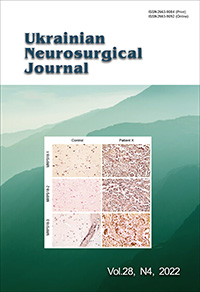Expression pattern of MRPS18 family genes in medulloblastoma: a case report
DOI:
https://doi.org/10.25305/unj.265302Keywords:
embryonal tumors, medulloblastoma, MRPS18 family genes, proteins MRPS18-1, MRPS18-2 and MRPS18-3, RB gene, RB proteinAbstract
Medulloblastoma is one of the most prevalent brain tumors in children. Due to alterations in the gene expression patterns, medulloblastomas display diversity in the transcriptional, genetic, and clinical markers. However, these markers are few. Hence, there is an urgent need for other molecular, preferentially, non-invasive markers to propose the personalized treatment. One of the putative markers can be the mitochondrial ribosomal protein MRPS18-2.
Purpose: In the present work we aimed to study expression of the MRPS18 family genes at mRNA and protein levels, in serum and tissue of the medulloblastoma.
Materials and methods. To do so, a real-time quantitative polymerase chain reaction (qPCR) was used to assess the relative expression of RB and MRPS18 family genes at mRNA levels in patient sera and tissue. Protein signals were detected by immunohistochemistry. The relative expression of MRPS18 genes was lower, when assessed in serum of the tumor patient compared with the control.
Results. Thus, MRPS18-1 expression level, detected in serum, is up to 8.5-folds lower than in the control sample, while in tissue it is quite similar in both samples. The MRPS18-2 gene was detected at up to 26-fold lower levels in the serum of the tumor patient. Importantly, MRPS18-2 and MRPS18-3 are elevated by 13- and 7.2-fold, respectively, in tumor tissue, compared to the control. Moreover, the MRPS18-2 protein signal is dramatically elevated in medulloblastoma cells, compared with the conditionally healthy brain tissue.
Concluding, the members of the MRPS18 protein family, especially MRPS18-2, are the putative candidates for molecular prognostic markers. More experiments should be done on a study on this family, and on a large cohort.
References
Zozulya YA, Orlov YA. [The concept of pediatrics neurosurgery development in Ukraine from 2010 to 2015]. Ukrainian Neurosurgical Journal. 2010;(1):66-73. Ukrainian. doi: 10.25305/unj.88779
Ostrom QT, Patil N, Cioffi G, Waite K, Kruchko C, Barnholtz-Sloan JS. CBTRUS Statistical Report: Primary Brain and Other Central Nervous System Tumors Diagnosed in the United States in 2013-2017. Neuro Oncol. 2020 Oct 30;22(12 Suppl 2):iv1-iv96. doi: 10.1093/neuonc/noaa200
Miller KD, Ostrom QT, Kruchko C, Patil N, Tihan T, Cioffi G, Fuchs HE, Waite KA, Jemal A, Siegel RL, Barnholtz-Sloan JS. Brain and other central nervous system tumor statistics, 2021. CA Cancer J Clin. 2021 Sep;71(5):381-406. doi: 10.3322/caac.21693
Khan M, Wong K, Jardel D, Broggio J, Stiller C, McCabe M. Medulloblastoma incidence and survival-A Population Based Study. Neuro Oncol. 2018 Oct;20 (Suppl 5):v350-1. doi: 10.1093/neuonc/noy129.030
Weil AG, Wang AC, Westwick HJ, Ibrahim GM, Ariani RT, Crevier L, Perreault S, Davidson T, Tseng CH, Fallah A. Survival in pediatric medulloblastoma: a population-based observational study to improve prognostication. J Neurooncol. 2017 Mar;132(1):99-107. doi: 10.1007/s11060-016-2341-4
Orr BA. Pathology, diagnostics, and classification of medulloblastoma. Brain Pathol. 2020 May;30(3):664-678. doi: 10.1111/bpa.12837
Chernenko OG. [Features of continued growth and metastasis of cerebellar medulloblastoma]. Ukrainian Neurosurgical Journal. 2007;(2):29-36. Ukrainian. doi: 10.25305/unj.130680
Quinlan A, Rizzolo D. Understanding medulloblastoma. JAAPA. 2017 Oct;30(10):30-36. doi: 10.1097/01.JAA.0000524717.71084.50
Hoshide R, Jandial R. 2016 World Health Organization Classification of Central Nervous System Tumors: An Era of Molecular Biology. World Neurosurg. 2016 Oct;94:561-562. doi: 10.1016/j.wneu.2016.07.082
Louis DN, Perry A, Wesseling P, Brat DJ, Cree IA, Figarella-Branger D, Hawkins C, Ng HK, Pfister SM, Reifenberger G, Soffietti R, von Deimling A, Ellison DW. The 2021 WHO Classification of Tumors of the Central Nervous System: a summary. Neuro Oncol. 2021 Aug 2;23(8):1231-1251. doi: 10.1093/neuonc/noab106
Northcott PA, Buchhalter I, Morrissy AS, Hovestadt V, Weischenfeldt J, Ehrenberger T, et al. The whole-genome landscape of medulloblastoma subtypes. Nature. 2017 Jul 19;547(7663):311-317. doi: 10.1038/nature22973
Cavalli FMG, Remke M, Rampasek L, Peacock J, Shih DJH, Luu B, et al. Intertumoral Heterogeneity within Medulloblastoma Subgroups. Cancer Cell. 2017 Jun 12;31(6):737-754.e6. doi: 10.1016/j.ccell.2017.05.005
Morrissy AS, Cavalli FMG, Remke M, Ramaswamy V, Shih DJH, Holgado BL, et al. Spatial heterogeneity in medulloblastoma. Nat Genet. 2017; 49(5): 780-788. doi: 10.1038/ng.3838
Kashuba E, Mushtaq M. Do MRPS18-2 and RB proteins cooperate to control cell stemness and differentiation, preventing cancer development? Exp Oncol. 2017 Mar;39(1):12-16. doi: 10.31768/2312-8852.2017.39(1):12-16
Mushtaq M, Kovalevska L, Darekar S, Abramsson A, Zetterberg H, Kashuba V, Klein G, Arsenian-Henriksson M, Kashuba E. Cell stemness is maintained upon concurrent expression of RB and the mitochondrial ribosomal protein S18-2. Proc Natl Acad Sci U S A. 2020 Jul 7;117(27):15673-15683. doi: 10.1073/pnas.1922535117
Mints M, Mushtaq M, Iurchenko N, Kovalevska L, Stip MC, Budnikova D, Andersson S, Polischuk L, Buchynska L, Kashuba E. Mitochondrial ribosomal protein S18-2 is highly expressed in endometrial cancers along with free E2F1. Oncotarget. 2016 Apr 19;7(16):22150-8. doi: 10.18632/oncotarget.7905
Mushtaq M, Ali RH, Kashuba V, Klein G, Kashuba E. S18 family of mitochondrial ribosomal proteins: evolutionary history and Gly132 polymorphism in colon carcinoma. Oncotarget. 2016 Aug 23;7(34):55649-55662. doi: 10.18632/oncotarget.10957
Downloads
Published
How to Cite
Issue
Section
License
Copyright (c) 2023 Larysa M. Kovalevska, Valeriia M. Shcherbina, Serhii S. Kalman, Ludmila M. Verbova, Volodymyr D. Rozumenko, Tetyana A. Malysheva, Elena V. Kashuba

This work is licensed under a Creative Commons Attribution 4.0 International License.
Ukrainian Neurosurgical Journal abides by the CREATIVE COMMONS copyright rights and permissions for open access journals.
Authors, who are published in this Journal, agree to the following conditions:
1. The authors reserve the right to authorship of the work and pass the first publication right of this work to the Journal under the terms of Creative Commons Attribution License, which allows others to freely distribute the published research with the obligatory reference to the authors of the original work and the first publication of the work in this Journal.
2. The authors have the right to conclude separate supplement agreements that relate to non-exclusive work distribution in the form of which it has been published by the Journal (for example, to upload the work to the online storage of the Journal or publish it as part of a monograph), provided that the reference to the first publication of the work in this Journal is included.









